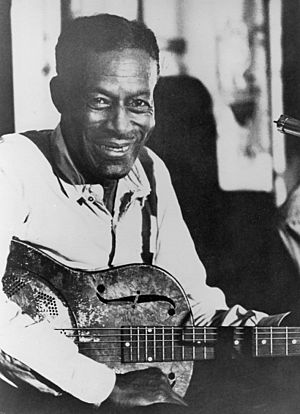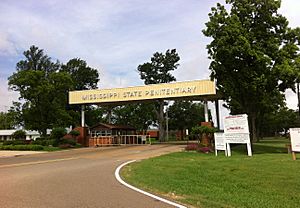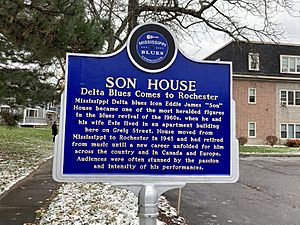Son House facts for kids
Quick facts for kids
Son House
|
|
|---|---|
 |
|
| Background information | |
| Birth name | Edward James House Jr. |
| Born | March 21, 1902 Lyon, Mississippi, U.S. |
| Died | (aged 86) Detroit, Michigan |
| Genres | Delta blues |
| Occupation(s) | Musician |
| Instruments |
|
| Years active | 1930–1943, 1964–1974 |
| Labels | |
Edward James "Son" House Jr. (born March 21, 1902 – died October 19, 1988) was an American Delta blues singer and guitarist. He was known for his very emotional singing and his unique slide guitar playing style.
Son House started playing blues music when he was 25 years old. Before that, he was a preacher and even a church pastor. He used the strong feelings and powerful voice from his preaching in his blues music. He quickly became a skilled musician. Charley Patton, a famous blues artist from the Mississippi Delta, invited Son House to play with him. They also recorded music together in 1930 for Paramount Records.
The records did not sell well because the Great Depression had just started. But Son House remained popular in his local area. In the 1930s, he and Willie Brown were top musicians in Coahoma County. He greatly influenced other famous blues musicians like Robert Johnson and Muddy Waters. In 1941 and 1942, Alan Lomax and John W. Work recorded Son House and his band for the Library of Congress and Fisk University. In 1943, he moved to Rochester, New York, and stopped playing music for a while.
In 1964, some young record collectors found Son House. They knew his music from his old records. They encouraged him to play again. He started a new career, performing for young audiences at coffeehouses and folk festivals. He was called a "folk blues" singer. He recorded several new albums. Son House passed away in 1988. In 2017, his song "Preachin' the Blues" was added to the Blues Hall of Fame.
Contents
Son House's Early Life
Son House was born in a small village called Lyon. This was north of Clarksdale, Mississippi. He was the second of three brothers. He lived in the rural Mississippi Delta until his parents separated. He was about seven or eight years old at that time. His father, Eddie House Sr., was a musician who played the tuba and sometimes the guitar. He was also a church member and later became a Baptist deacon.
Young Eddie House, or Son House, loved religion and going to church. He also loved music, like his family. But he only liked singing. He was not interested in playing instruments like his family's band. He also did not like blues music because of his religious beliefs.
When his parents separated, Son House's mother took him to Tallulah, Louisiana. This town is across the Mississippi River from Vicksburg, Mississippi. When he was a teenager, they moved to Algiers, New Orleans. He often said he hated the blues and loved going to church. He even called himself "churchy." When he was fifteen, he started preaching sermons. This was likely when he lived in Algiers.
At age nineteen, while living in the Delta, he married Carrie Martin. She was an older woman from New Orleans. This was a big step for Son House. He got married in church, even though his family did not approve. The couple moved to her hometown of Centerville, Louisiana. They went there to help run her father's farm. After a few years, Son House felt used and unhappy. He remembered, "I left her hanging on the gatepost." Around the same time, probably in 1922, Son House's mother died.
Son House did not like farming. He also disliked many of the simple jobs he took as a young man. He moved often. Once, he went to East Saint Louis to work in a steel factory. The only job he enjoyed was on a horse ranch in Louisiana. He later wore a cowboy hat during his performances to remember this time.
He found a way to escape hard manual labor. In his early twenties, he had a religious experience. He then became a paid pastor. First, he was a pastor in the Baptist Church. Then, he became a pastor in the Colored Methodist Episcopal Church. However, he started doing things that did not fit with being a pastor. This led him to leave the church after several years. He stopped being a full-time pastor, but he still preached sermons sometimes.
Becoming a Blues Performer
In 1927, when he was 25, Son House's view on music changed very quickly. In a small village near Clarksdale, he heard a friend playing bottleneck guitar. He had never heard this style before. He immediately changed his mind about the blues. He bought a guitar from a musician named Frank Hoskins. Within weeks, he was playing with Hoskins and other musicians. Two songs he learned then became some of his most famous: "My Black Mama" and "Preachin' the Blues."
Another musician who inspired him was Rube Lacey. Lacey was a more famous performer. In a very short time, Son House became a professional blues musician. His style was based on his religious singing and simple bottleneck guitar playing.
In early 1930, Son House took a train to Lula, Mississippi. This town was near the blues center of Helena, Arkansas. Charley Patton, a great Delta blues star, was also in Lula. Patton and his partner Willie Brown were the main blues players there. Patton saw Son House busking (playing music for money) at the train station. He saw how Son House attracted a crowd. Patton then invited Son House to play music regularly with him and Brown.
Recording Music
In 1930, Art Laibly from Paramount Records came to Lula. He wanted Patton to record more songs. Son House, Willie Brown, and pianist Louise Johnson went with Patton to Grafton, Wisconsin. All of them recorded songs for the record label. Son House recorded nine songs. Eight of these were released, but they did not sell well. He did not record commercially again for 35 years. However, he continued to play with Patton and Brown. After Patton died in 1934, he kept playing with Brown. During this time, Son House worked as a tractor driver on farms.
Alan Lomax recorded Son House for the Library of Congress in 1941. Willie Brown, mandolin player Fiddlin' Joe Martin, and harmonica player Leroy Williams played with Son House on these recordings. Lomax returned in 1942 and recorded Son House again.
After this, Son House left the public eye. He moved to Rochester, New York, in 1943. He worked as a railroad porter for the New York Central Railroad and as a chef.
Rediscovery and Later Career
In 1964, a group of record collectors found Son House in Rochester, New York. He was working at a train station. He had been away from music for many years. He did not know about the new interest in folk blues music.
After being found, he toured a lot in the United States and Europe. He recorded for CBS Records. Like Mississippi John Hurt, he was welcomed into the music scene of the 1960s. He played at the Newport Folk Festival in 1964. He also performed at the New York Folk Festival in 1965. In 1967, he toured Europe with other blues artists.
A young guitarist named Alan Wilson was a big fan of Son House. A music producer asked Wilson to help Son House remember his old songs. Son House then recorded the album Father of Folk Blues. This album was later re-released as Father of Delta Blues: The Complete 1965 Sessions. Son House also performed live with Wilson.
Son House performed in Seattle in 1968. This concert was recorded and later released as a CD. In 1970, Son House toured Europe again. He played at the Montreux Jazz Festival. A recording of his London concerts was released. He also played at a blues festival in Toronto in 1974. On a TV show, he was joined by blues guitarist Buddy Guy.
Son House had health problems in his later years. In 1974, he stopped performing again. He moved to Detroit, Michigan. He stayed there until he passed away from cancer of the larynx. He had been married five times. He was buried at Mt. Hazel Cemetery. Members of the Detroit Blues Society raised money to put a monument on his grave.
Honors and Awards
In 2007, Son House was honored with a marker on the Mississippi Blues Trail in Tunica, Mississippi.
In 2017, his song "Preachin' the Blues" was added to the Blues Hall of Fame.
Discography
78-RPM Recordings
These songs were recorded on May 28, 1930, in Grafton, Wisconsin, for Paramount Records.
- "Walking Blues" (found in 1985)
- "My Black Mama – Part I"
- "My Black Mama – Part II"
- "Preachin' the Blues – Part I"
- "Preachin' the Blues – Part II"
- "Dry Spell Blues – Part I"
- "Dry Spell Blues – Part II"
- "Clarksdale Moan" (found in 2006)
- "Mississippi County Farm Blues" (found in 2006)
Recordings for Library of Congress and Fisk University
These were recorded in August 1941, at Klack's Store, Lake Cormorant, Mississippi.
- "Levee Camp Blues", with Willie Brown, Fiddlin' Joe Martin, Leroy Williams
- "Government Fleet Blues", with Brown, Martin, Williams
- "Walking Blues", with Brown, Martin, Williams
- "Shetland Pony Blues", with Brown
- "Fo' Clock Blues", with Brown, Martin
- "Camp Hollers", with Brown, Martin, Williams
- "Delta Blues", with Williams
These were recorded on July 17, 1942, in Robinsonville, Mississippi.
- "Special Rider Blues"
- "Low Down Dirty Dog Blues"
- "Depot Blues"
- "Key of Minor" (Interviews: Showing how to tune a guitar)
- "American Defense"
- "Am I Right or Wrong"
- "Walking Blues"
- "County Farm Blues"
- "The Pony Blues"
- "The Jinx Blues (No. 1)"
- "The Jinx Blues (No. 2)"
The music from both sessions and most of the interviews have been re-released on LP and CD.
Singles
- "The Pony Blues" / "The Jinx Blues", Part 1 (1967)
- "Make Me a Pallet on the Floor" (Willie Brown) / "Shetland Pony Blues" (1967)
- "Death Letter" (1985)
Other Albums
- The Complete Library of Congress Sessions (1964)
- Blues from the Mississippi Delta, with J. D. Short (1964)
- The Legendary Son House: Father of Folk Blues (1965)
- In Concert (Oberlin College, 1965)
- Delta Blues (1941–1942)
- Son House & Blind Lemon Jefferson (1926–1941)
- The Real Delta Blues (1964–1965 recordings)
- Son House & the Great Delta Blues Singers, with Willie Brown and others
- Son House at Home: Complete 1969
- Son House (Library of Congress)
- John the Revelator
- American Folk Blues Festival '67 (1 cut)
- Son House (1965-1969)
- Son House – Vol. 2 (1964–1974) (1987)
- Father of the Delta Blues: The Complete 1965 Sessions
- Living Legends (1 cut, 1966)
- Real Blues (1 cut, University of Chicago, 1964)
- John the Revelator: The 1970 London Sessions
- Son House (1964–1970) (limited edition)
- Great Bluesmen/Newport, (2 cuts, 1965)
- Blues with a Feeling (3 cuts, 1965)
- Masters of the Country Blues, House and Bukka White
- Delta Blues and Spirituals (1995)
- In Concert (Live) (1996)
- "Live" at Gaslight Cafe, N.Y.C., January 3, 1965 (2000)
- New York Central Live (2003)
- Delta Blues (1941–1942) (2003)
- Classic Blues from Smithsonian Folkways (2003)
- Classic Blues from Smithsonian Folkways, vol. 2 (2003)
- The Very Best of Son House: Heroes of the Blues (2003)
- Proper Introduction to Son House (2004)
See also
 In Spanish: Son House para niños
In Spanish: Son House para niños



